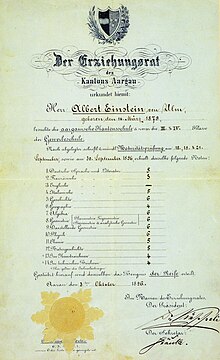

A letterhead is the heading at the top of a sheet of letter paper (stationery). It consists of a name, address, logo or trademark, and sometimes a background pattern.


A letterhead is the heading at the top of a sheet of letter paper (stationery). It consists of a name, address, logo or trademark, and sometimes a background pattern.
Many companies and individuals prefer to create a letterhead template in a word processor or other software application. That generally includes the same information as pre-printed stationery but at lower cost. Letterhead can then be printed on stationery or plain paper, as needed, on a local output device or sent electronically.
Letterheads are generally printed by either the offset or letterpress methods. In most countries outside North America, company letterheads are printed A4 in size (210 mm x 297 mm). [1] In North America, the letter size is typically 8.5 x 11 inches (215 x 280 mm).
Although modern technology makes letterheads very easy to imitate, they continue to be used as evidence of authenticity. [2] [3]

In computing, a printer is a peripheral machine which makes a persistent representation of graphics or text, usually on paper. While most output is human-readable, bar code printers are an example of an expanded use for printers. Different types of printers include 3D printers, inkjet printers, laser printers, and thermal printers.

ISO 216 is an international standard for paper sizes, used around the world except in North America and parts of Latin America. The standard defines the "A", "B" and "C" series of paper sizes, which includes the A4, the most commonly available paper size worldwide. Two supplementary standards, ISO 217 and ISO 269, define related paper sizes; the ISO 269 "C" series is commonly listed alongside the A and B sizes.

An envelope is a common packaging item, usually made of thin, flat material. It is designed to contain a flat object, such as a letter or card.

Paper size standards govern the size of sheets of paper used as writing paper, stationery, cards, and for some printed documents.

Stationery refers to commercially manufactured writing materials, including cut paper, envelopes, writing implements, continuous form paper, and other office supplies. Stationery includes materials to be written on by hand or by equipment such as computer printers.

A rubber stamp is an image or pattern that has been carved, molded, laser engraved, or vulcanized onto a sheet of rubber. Rubber stamping, also called stamping, is a craft in which some type of ink made of dye or pigment is applied to a rubber stamp, and used to make decorative images on some media, such as paper or fabric.

Business cards are cards bearing business information about a company or individual. They are shared during formal introductions as a convenience and a memory aid. A business card typically includes the giver's name, company or business affiliation and contact information such as street addresses, telephone number(s), fax number, e-mail addresses and website. Before the advent of electronic communication, business cards also included telex details. Now they may include social media addresses such as Facebook, LinkedIn and Twitter. Traditionally, many cards were simple black text on white stock, and the distinctive look and feel of cards printed from an engraved plate was a desirable sign of professionalism. In the late 20th century, technological advances drove changes in style, and today a professional business card will often include one or more aspects of striking visual design.
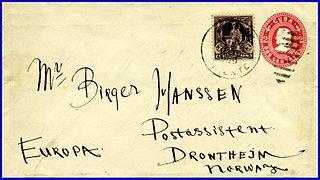
A stamped envelope or postal stationery envelope (PSE) is an envelope with a printed or embossed indicium indicating the prepayment of postage. It is a form of postal stationery.

Offset printing is a common printing technique in which the inked image is transferred from a plate to a rubber blanket and then to the printing surface. When used in combination with the lithographic process, which is based on the repulsion of oil and water, the offset technique employs a flat (planographic) image carrier. Ink rollers transfer ink to the image areas of the image carrier, while a water roller applies a water-based film to the non-image areas.
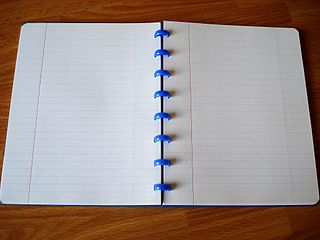
Ruled paper is writing paper printed with lines as a guide for handwriting. The lines often are printed with fine width and in light colour and such paper is sometimes called feint-ruled paper. Additional vertical lines may provide margins, act as tab stops or create a grid for plotting data; for example, graph paper is divided into squares by horizontal and vertical lines.
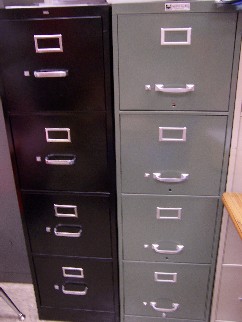
A filing cabinet is a piece of office furniture for storing paper documents in file folders. In the most simple context, it is an enclosure for drawers in which items are stored. The two most common forms of filing cabinets are vertical files and lateral files. A vertical file cabinet has drawers that extend from the short side of the cabinet. A lateral file cabinet has drawers that extend from the long side of the cabinet. These are also called side filers in Great Britain. There are also shelf files which go on shelves. In the United States, file cabinets are usually built to accommodate 8.5 × 11 paper, and in other countries, filing cabinets are often designed to hold other sizes of paper, such as A4 paper.
A loose leaf is a piece of paper of any kind that is not bound in place, or available on a continuous roll, and may be punched and organized as ring-bound or disc-bound. Loose leaf paper may be sold as free sheets, or made up into notepads, where perforations or glue allow them to be removed easily. "Leaf" in many languages refers to a sheet or page of paper, as in Folio, as in feuille de papier (French), hoja de papel (Spanish), foglio di carta (Italian), and ルーズリーフ.
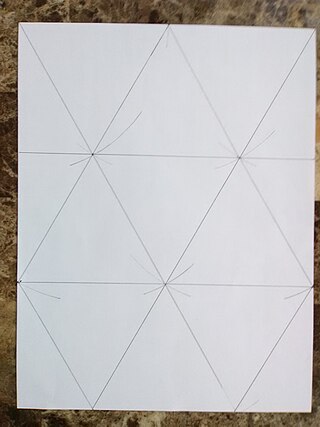
Letter is a paper size standard defined in ANSI/ASME Y14.1 by the American National Standards Institute, commonly used as home or office stationery primarily in the United States, Canada, and the Philippines, and variably across Latin America. It measures 8.5 by 11 inches and is similar in use to the A4 paper standard at 210 mm × 297 mm used by most other countries, defined in ISO 216 by the International Organization for Standardization.
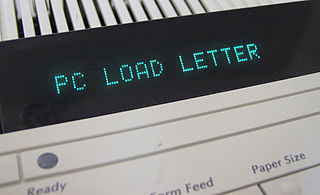
PC LOAD LETTER is a printer error message that has entered popular culture as a technology meme referring to a confusing or inappropriate error message. The message is instructing the user to refill the paper tray with letter-sized paper. The error message's vagueness was mocked in the 1999 comedy film Office Space.
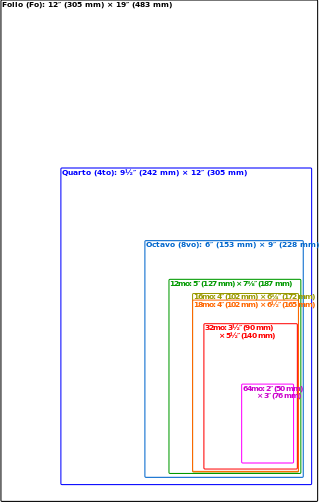
The size of a book is generally measured by the height against the width of a leaf, or sometimes the height and width of its cover. A series of terms is commonly used by libraries and publishers for the general sizes of modern books, ranging from folio, to quarto (smaller) and octavo. Historically, these terms referred to the format of the book, a technical term used by printers and bibliographers to indicate the size of a leaf in terms of the size of the original sheet. For example, a quarto historically was a book printed on sheets of paper folded in half twice, with the first fold at right angles to the second, to produce 4 leaves, each leaf one fourth the size of the original sheet printed – note that a leaf refers to the single piece of paper, whereas a page is one side of a leaf. Because the actual format of many modern books cannot be determined from examination of the books, bibliographers may not use these terms in scholarly descriptions.

An exercise book or composition book is a notebook that is used in schools to copy down schoolwork and notes. A student will usually have different exercise books for each separate lesson or subject.

In philatelic terminology a letter sheet, often written lettersheet, is a sheet of paper that can be folded, usually sealed, and mailed without the use of an envelope, or it can also be a similar item of postal stationery issued by a postal authority. Letter sheets derive from the form in which written correspondence was made up before the mid-19th century—letters were written on one or more sheets of paper that were folded and sealed in such a way that the address could be written on the outside.

Continuous stationery (UK) or continuous form paper (US) is paper which is designed for use with dot-matrix and line printers with appropriate paper-feed mechanisms. Other names include fan-fold paper, sprocket-feed paper, burst paper, lineflow, tractor-feed paper, and pin-feed paper. It can be single-ply or multi-ply, often described as multipart stationery or forms. Continuous stationery is often used when the final print medium is less critical in terms of the appearance at the edges, and when continuously connected individual sheets are not inconvenient for the application. Individual sheets can be separated at the perforation, and sheets also have edges with punched holes, which also can be removed at the perforation.

Paper is a thin sheet material produced by mechanically or chemically processing cellulose fibres derived from wood, rags, grasses, or other vegetable sources in water, draining the water through a fine mesh leaving the fibre evenly distributed on the surface, followed by pressing and drying. Although paper was originally made in single sheets by hand, almost all is now made on large machines—some making reels 10 metres wide, running at 2,000 metres per minute and up to 600,000 tonnes a year. It is a versatile material with many uses, including printing, painting, graphics, signage, design, packaging, decorating, writing, and cleaning. It may also be used as filter paper, wallpaper, book endpaper, conservation paper, laminated worktops, toilet tissue, currency, and security paper, or in a number of industrial and construction processes.

A compliments slip is a slip of paper that contains the same name and address information that would be on a letterhead of formal letter stationery, the pre-printed salutation "with compliments" or "with our/my compliments", and space afterwards for a short handwritten message to be added. It is used in correspondence, as an enclosure for other material.